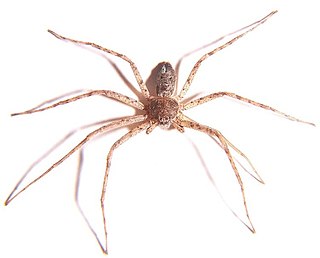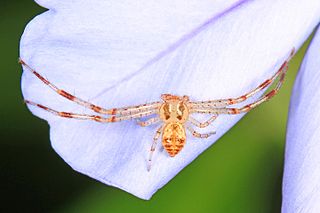
The Thomisidae are a family of spiders, including about 170 genera and over 2,100 species. The common name crab spider is often linked to species in this family, but is also applied loosely to many other families of spiders. Many members of this family are also known as flower spiders or flower crab spiders.

Philodromidae, also known as philodromid crab spiders and running crab spiders, is a family of araneomorph spiders first described by Tord Tamerlan Teodor Thorell in 1870. It contains over 500 species in thirty genera.

Misumena is a genus of crab spiders sometimes referred to as flower crab spiders. They are similar in appearance to several other genera in the family Thomisidae, such as Misumenoides and Mecaphesa.

Misumenops is a common genus of crab spider with more than 50 described species.

Misumenoides is a genus of spiders in the family Thomisidae. Spiders in this family are commonly called "crab" or "flower" spiders.
Henriksenia nepenthicola, synonym Misumenops nepenthicola, is a species of crab spider. It is native to Singapore. It lives inside the pitchers of a number of lowland Nepenthes pitcher plants. As such, it is classified as a nepenthephile. They are slow-moving spiders which do not actively hunt. Males and females both reach a length of 6 mm.

Misumena vatia is a species of crab spider with a holarctic distribution. In North America, it is called the goldenrod crab spider or flower (crab) spider, as it is commonly found hunting in goldenrod sprays and milkweed plants. They are called crab spiders because of their unique ability to walk sideways as well as forwards and backwards. Both males and females of this species progress through several molts before reaching their adult sizes, though females must molt more to reach their larger size. Females can grow up to 10 mm (0.39 in) while males are quite small, reaching 5 mm (0.20 in) at most. Misumena vatia are usually yellow or white or a pattern of these two colors. They may also present with pale green or pink instead of yellow, again, in a pattern with white. They have the ability to change between these colors based on their surroundings through the molting process. They have a complex visual system, with eight eyes, that they rely on for prey capture and for their color-changing abilities. Sometimes, if Misumena vatia consumes colored prey, the spider itself will take on that color.

Misumenoides formosipes is a species of crab spiders (Thomisidae), belonging to the genus Misumenoides. The species' unofficial common name is white banded crab spider, which refers to a white line that runs through the plane of their eyes. This species is a sit-and-wait predator that captures pollinators as they visit the inflorescences on which the spider sits. The spider has strong front legs which are used to seize prey. The female spider is much larger than the male. The pattern of markings on females is variable and the overall color of the body can change between white and yellow dependent on the color of their surroundings. The color pattern for males, which does not change in their lifetime, differs from females in that the four front legs of males are darker and the abdomen is gold. The spider can be found throughout the United States. Males search for sedentary females within a heterogeneous habitat and guard them until they are sexually mature to reproduce.

Synema globosum is a species of spiders belonging to the family Thomisidae. It is sometimes called the Napoleon spider, because of a supposed resemblance of the markings on the abdomen to a silhouette of Napoleon wearing his iconic hat.
Ansiea is a genus of crab spiders that was first described by Pekka T. Lehtinen in 2004. This genus was named in honour of South African arachnologist Ansie Dippenaar-Schoeman. As of June 2020 it contains two species found in Africa and Saudi Arabia: A. buettikeri and A. tuckeri.

Misumessus is a genus of North American and Caribbean crab spiders first described by Nathan Banks in 1904. They look similar to members of Misumena, but are much spinier. It was considered a monotypic genus until 2017, but its taxonomic standing has been debated throughout the 20th century, first as a synonym of Misumenops, then later as its subgenus. It was raised to genus status in 2008, but has still been confused with similar genera, some of which were only known by character descriptions made by Eugène Simon nearly fifty years earlier.

Misumenops bellulus is a species of crab spider in the family Thomisidae. It is found in the USA, Cuba, and the Virgin Islands.

Mecaphesa celer, known generally as the swift crab spider, is a species of crab spider in the family Thomisidae. Its range is quite large, and it is found throughout much of North and Central America.

Ebrechtella tricuspidata is a species of crab spiders belonging to the family Thomisidae.

Thomisus spectabilis, also known as the white crab spider or Australian crab spider, is a small spider found in Australia and far east Asia.

Tmarus piger is a species of crab spider belonging to the family Thomisidae.
Parabomis wandae is a species of crab spider in the genus Parabomis that lives in Ghana, Ivory Coast, Kenya and Rwanda. The species was first described in 2020 by Ansie Dippenaar-Schoeman and Stefan Foord. It thrives in rainforests. The spider is very small, with a total length between 1.9 and 2.26 mm. The female is larger and lighter in colour than the male. It has a distinctive hump to the abdomen, which for the female is less pronounced. The female abdomen has dark patches and spots on its white surface, while the male has a brown shell. The species can be differentiated from other members of the genus by its copulatory organs. The male has a distinctive beak-like end of the retrolateral tibial apophysis. The female has an egg-shaped epigyne with long copulatory ducts.
Henriksenia labuanica is a species of spider in the family Thomisidae, found in Malaysia (Borneo).

Misumenini is a tribe of spiders in the family Thomisidae.

















